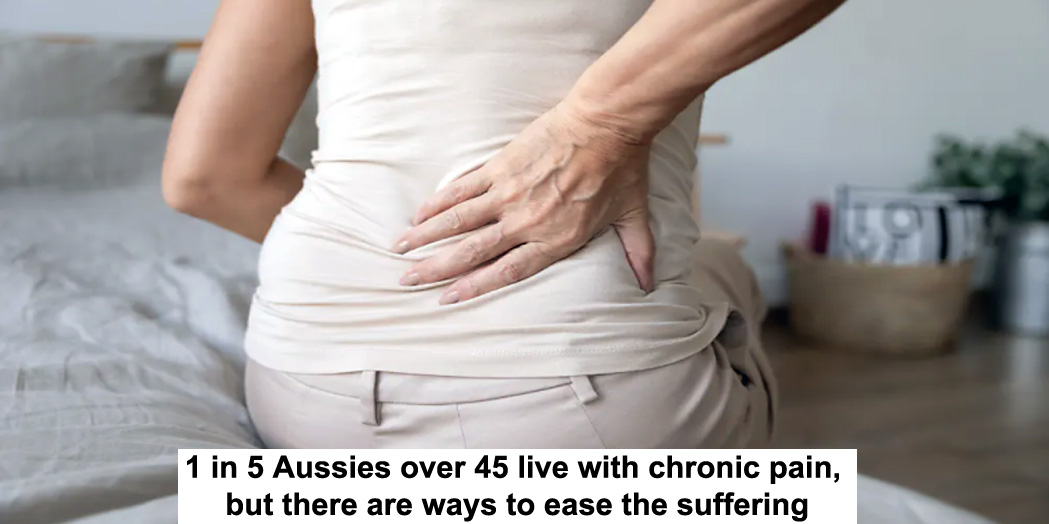There is a way to ease that pain
Around 1.6 million Australians aged 45 or over have been living with persistent pain, according to newly released data from the Australian Institute of Health and Welfare.
The figures, which cover 2016-17, reveal that GP consultations for chronic pain increased by 67% in the preceding decade. The number of visits for lower back pain increased by 400,000.
Dealing with chronic pain also means you are likely to face longer hospital stays, much poorer mental health and are three times more likely than normal to be taking painkillers regularly. About 105,000 people were hospitalised with chronic pain in 2017-18, with a typical hospital stay three times longer than average.
Behind those figures lies the human cost. As a clinical specialist in pain medicine, I see the jobs lost, the mortgage defaults, the superannuation withdrawals, and the family roles given up because of debilitating pain.
Lower back pain, migraine and pain following trauma are among the top 10 causes of years lost to disability worldwide, and this has barely changed over the past 20 years. Because chronic pain can happen at any stage of life, many people have to live with it for decades.
A 2019 Deloitte Access Economics report commissioned by advocacy group Painaustralia estimated the annual cost to Australia’s economy at A$139.3 billion per year, more than A$20 billion of which comes directly out of the pockets of pain patients.
A fresh approach
The most expensive and inefficient way to manage this national crisis is pretty much the way we are currently doing it. Chronic pain care is too fragmented and too often delivered by those without the most up-to-date training.
Yet most of the really effective treatments can be delivered at a relatively low cost and with low-tech means. Here are some potential solutions that pain doctors and researchers are confident will work.
- Medications need to be carefully chosen and ruthlessly abandoned if they are not helping. The Pharmaceutical Benefits Scheme (PBS) currently spends more than A$170m a year on drugs such as sustained-release opioids and pregabalin. This could be reduced if more doctors prescribed them in accordance with best practice knowledge. This would help patients and taxpayers alike.
- Skilled interventions such as inpatient infusions of medications like ketamine, or invasive procedures such as radiofrequency neurotomy, need to be provided according to appropriate quality standards so resources are not wasted and patients are not put at risk.
- PBS funding should be extended to cover effective treatments for specific conditions such as migraines.
- Proven treatments such as group pain programs and individual therapy sessions with credentialed allied health specialists need to be supported by Medicare. These are essential for building the self-management skills needed to reduce patients’ reliance on pain medication.
- We need a massive investment in training and service redesign for agencies that deal with chronic pain as a result of work or transport injuries.
- High-quality pain care should be viewed not as a luxury for hospitals, but an essential part of the health-care ecosystem. Pain care should be integrated throughout the public health system, in both acute and subacute care, where it can shorten inpatient stays and improve rehabilitation.
- We should restrict access to low-value treatments like repeated surgery or medications that have not been working.
In the void created by the huge unmet need and the limited availability of expert pain care, an industry of highly dubious usefulness has been allowed to flourish. Social media is full of false hope. Supplements such as glucosamine, curcumin and fish oil are not supported by credible studies, yet they are still promoted commercially as effective.
Dodgy arthritis “cures” and devices that claim to relieve pain using magnets or electricity are everywhere. Despite dismal supporting evidence, the medical cannabis industry continues to sell itself to chronic pain patients.
Read more: I’m taking glucosamine for my arthritis. So what’s behind the new advice to stop?
While the COVID-19 pandemic continues, it can be hard to focus on other health issues. But Australia already has a path to improving life for many thousands of chronic pain sufferers. The federal government has developed a strategic plan for pain management that offers a blueprint for future action.
The plan calls for upskilling of all primary care health professionals to help them recognise the early stages of a chronic pain problem and nip it in the bud. If implemented, it will bring the dream of timely access to well-resourced expert interdisciplinary pain teams in the regions and outer suburbs closer to reality.
Most importantly, we need a community-wide effort to destigmatise persistent pain and those who suffer from it. After all, the chances are you either have it or you live or work with someone who does.
This article was written by:
Disclosure statement
Michael Vagg is the current Dean of the Faculty of Pain Medicine, Australian and New Zealand College of Anaesthetists







